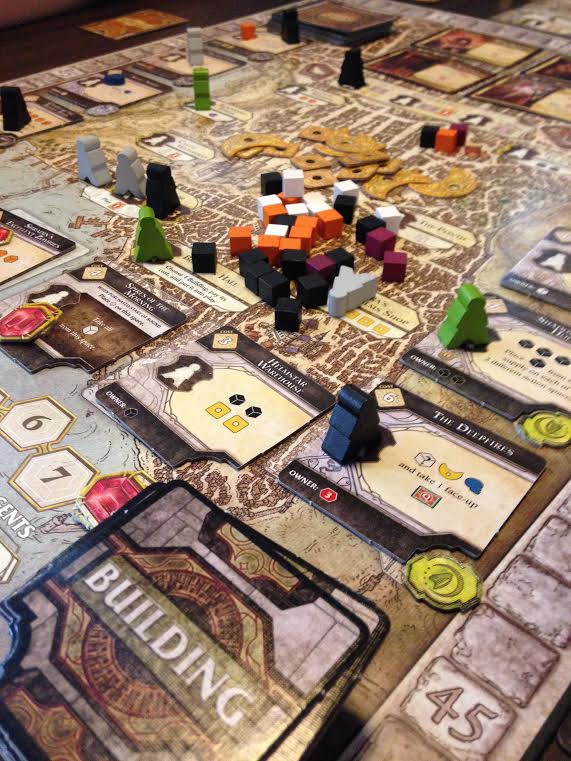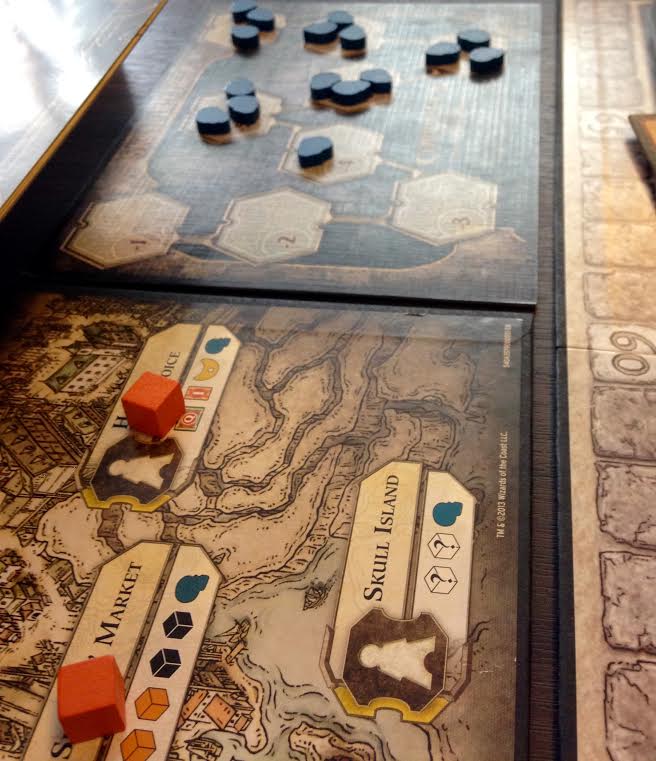This week’s Monday Night Gaming: Scoundrels of Skullport, the expansion for the game, The Lords of Waterdeep.
 Publisher: Wizards of the Coast
Publisher: Wizards of the Coast
# of Players: 2-6
Best with: 3-4 players
While this post is going live on its normal Monday, we didn’t play this for “Monday Night Gaming” this time. Instead, we played it on Saturday for International Tabletop Day!
I’m a huge fan of The Lords of Waterdeep (you can read my full review here), so I was pretty excited to try out its expansion, Scoundrels of Skullport.
We’d heard excellent things about this expansion, so it was the perfect game to test out for International Tabletop Day.
General Mechanics: I won’t cover the general mechanics for the base game in this and will assume you’re familiar with it already. (If not, you can check out the general mechanics of it here.)
This expansion adds two new areas for the game: the dungeons of Undermountain and the crime area of Skullport. In some ways, it’s like two expansions in one as both areas offer new Lords, buildings, Intrigue & Quest cards, and new ways to play. Players can play a game with either additions or both additions provided they use the new “long play” rules.
In all honesty, Undermountain mostly adds a few new locations for your adventurers to go during play, along with some additional cards and buildings. It was a tad underwhelming, which is, I suspect, why Wizards put both expansions in one box. The Skullport area is the main expansion and adds a new play element: corruption. Completing certain quests, playing certain intrigue cards, or even gathering certain resources can now gain a player corruption. At the end of the game, corruption penalizes the player and counts against their score.
How to Win/Lose: At the end of eight rounds, the Lord with the most victory points wins.
What I Liked: I like the idea of corruption. I like what they were trying to go for with this expansion, however….
What I Didn’t Like: The Skullport expansion, in my opinion, destroys the strategies in the base game and makes it all about gaining and removing corruption. Quests that used to be difficult (due to resources needed to complete them) and rewarded you as such for it with 15, maybe 20 victory points, are now nothing. The new expansion adds quests worth 40 points that take much fewer resources to complete. It doesn’t matter that they give you corruption because there are many new buildings that will remove it easily enough. There are also many quest cards that will remove 3+ corruption at a time, making it insanely easy to remove that pesky corruption.
Case in point, when we played on International Tabletop Day, our friend was able to complete 1 quest on the first turn that allowed him to purchase three buildings for free. All three buildings were buildings that cost 7+ gold (i.e. expensive!). One gave him 4-6 fighters every turn if he used it, and one gave him the ability to exchange those fighters for whatever resources he needed, including the previously hard-to-get wizards and priests. Because of this, he was able to complete 5+ forty point quests with ease and completed the game with no corruption. In fact, we all completed the game with no corruption.
Gone was the game where anyone could win if they used resources wisely. Instead, we were left with a game with way over-powered buildings, quest rewards, and Intrigue cards, where whoever took on the most corruption early on, basically won.
Another issue with the overpowered cards is how many were in play in the game. If we’d only seen 3-6 buildings and cards that get rid of corruption, it would be more balanced. Instead, the instructions have you remove a heavy chunk of the base game buildings and cards and replace them with almost twice as many buildings and cards from the expansion. Because of this, the overpowered buildings & cards far outnumber the base game ones, leading to an unbalanced game.
Also, in the base game, if you didn’t want your opponent to complete a quest, you could block them from gaining certain resources (such as the hard to get priests) by taking those spots yourself. With the expansion of the board itself, it added new ways to get the same things and thus, made it nigh impossible to block other players from gaining precious resources.
It is entirely possible that we had a perfect game scenario that allowed our friend to take control round one, one that didn’t give us any opportunity to ever catch up or stop him, but in all honesty, I think a game that perfect for the winner, shouldn’t be possible in round one, and if it is, it only goes to show how unbalanced the game truly is.
Overall Rating/Impression: The Skullport portion of the game feels way unbalanced and overpowered. I found the game much less fun than I’d expected. 6/10.


